初中全新英语语法——介词(共21张PPT)
文档属性
| 名称 | 初中全新英语语法——介词(共21张PPT) |  | |
| 格式 | ppt | ||
| 文件大小 | 2.1MB | ||
| 资源类型 | 教案 | ||
| 版本资源 | 通用版 | ||
| 科目 | 英语 | ||
| 更新时间 | 2022-04-10 18:28:47 | ||
图片预览

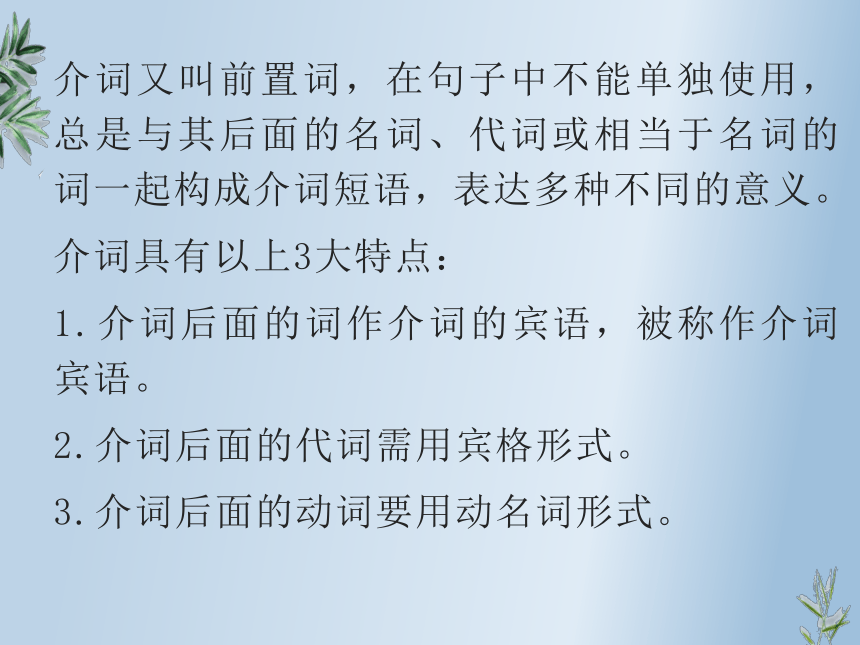


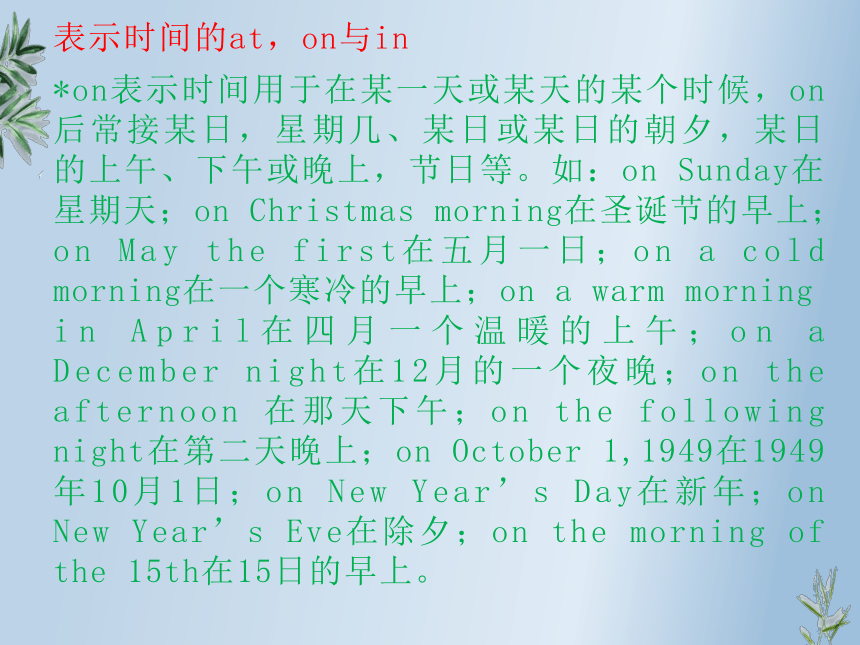
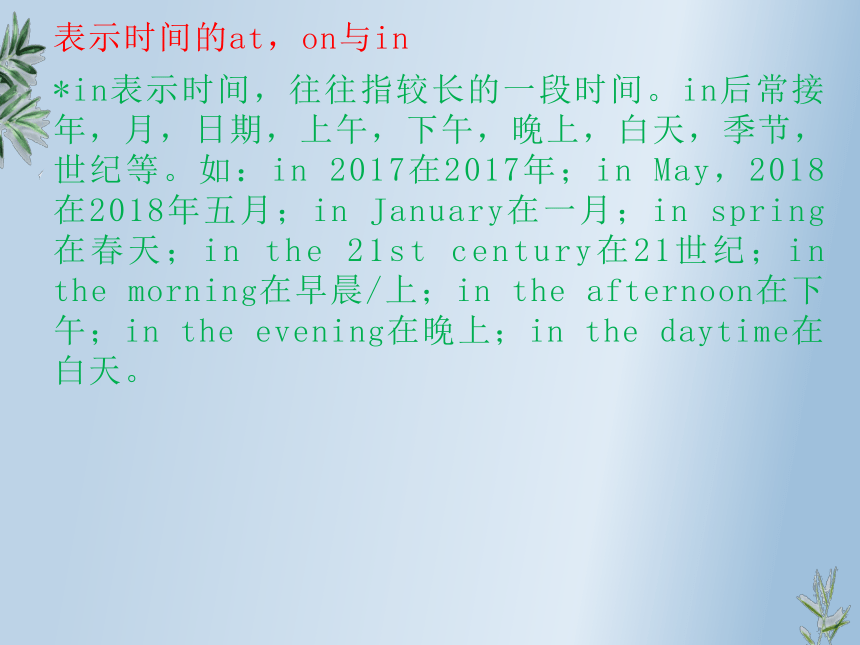

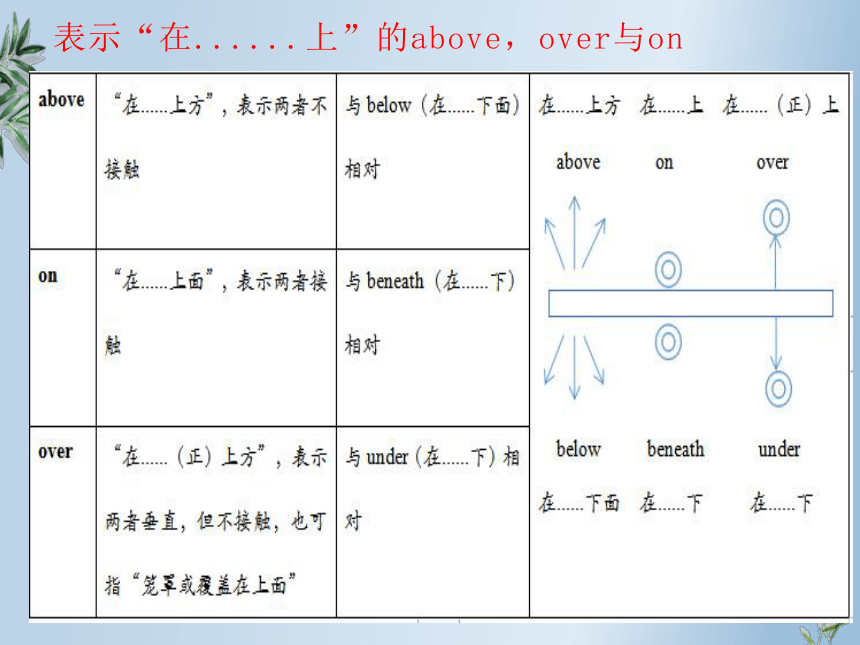
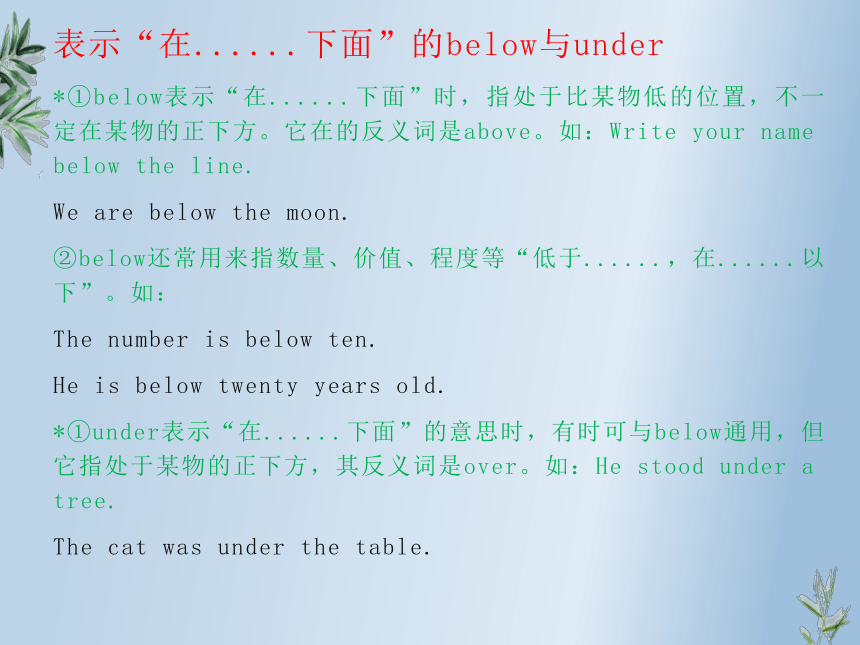
文档简介
(共21张PPT)
初中全新英语语法
介词
介词又叫前置词,在句子中不能单独使用,总是与其后面的名词、代词或相当于名词的词一起构成介词短语,表达多种不同的意义。
介词具有以上3大特点:
1.介词后面的词作介词的宾语,被称作介词宾语。
2.介词后面的代词需用宾格形式。
3.介词后面的动词要用动名词形式。
易混介词用法辨析
表示时间的at,on与in
*at表示时间用于在某时刻,at后常接几点几分,天明,中午,日出,日落,开始等。如:at five o'clock在五点;at five fifteen在五点十五;at dawn在黎明;at daybreak在天亮;at sunrise在日出时;at noon在中午;at sunset在日落时,at midnight在半夜;at that time在那时;at that moment在那会儿;at this time of day在一天的这个时候。
表示时间的at,on与in
*on表示时间用于在某一天或某天的某个时候,on后常接某日,星期几、某日或某日的朝夕,某日的上午、下午或晚上,节日等。如:on Sunday在星期天;on Christmas morning在圣诞节的早上;on May the first在五月一日;on a cold morning在一个寒冷的早上;on a warm morning in April在四月一个温暖的上午;on a December night在12月的一个夜晚;on the afternoon 在那天下午;on the following night在第二天晚上;on October 1,1949在1949年10月1日;on New Year’s Day在新年;on New Year’s Eve在除夕;on the morning of the 15th在15日的早上。
表示时间的at,on与in
*in表示时间,往往指较长的一段时间。in后常接年,月,日期,上午,下午,晚上,白天,季节,世纪等。如:in 2017在2017年;in May,2018在2018年五月;in January在一月;in spring在春天;in the 21st century在21世纪;in the morning在早晨/上;in the afternoon在下午;in the evening在晚上;in the daytime在白天。
表示地点的at,in与on
*at表示地点:①用于较小的地方。如:I shall wait for you at the station.
②用于门牌号码前。如:He lives at 115 Zhongshan Road.
*in表示地点:①用于较大的地方。如:He lives in Shanghai.
②虽然是很小的地方,如果说话人住在那里,也可用in。如:I live in my office.
*on表示地点,一般指与面或线接触的地方,意为“在......上;在......旁”。如:
The picture was hanging on the wall.
I live on the 7th floor at 21 Oxford Street in London.
表示“在......上”的above,over与on
表示“在......下面”的below与under
*①below表示“在......下面”时,指处于比某物低的位置,不一定在某物的正下方。它在的反义词是above。如:Write your name below the line.
We are below the moon.
②below还常用来指数量、价值、程度等“低于......,在......以下”。如:
The number is below ten.
He is below twenty years old.
*①under表示“在......下面”的意思时,有时可与below通用,但它指处于某物的正下方,其反义词是over。如:He stood under a tree.
The cat was under the table.
表示“通过、越过”的across,through与over
*across表示“横过、穿过”,指在某一平面或物体上从一边过到另一边去。如:
Please stop. The students are walking across the street.
*through表示“穿过、通过”,指从某处或某物中间通过或穿过,侧重点是从其空间、里面通过。如:
Once a man was walking through a forest,when he met two men.
*over意为“越过”,指从某物额上方越过。如:
The birds fly over the town.
表示“在......之间”的among与between
*among表示“在......之间”,指在三者或三者以上的人或物及物体当中或中间、之间。如:
There is a big lake among the mountains.
*between表示“在......之间”,指在两者之间,即两个独立的人或物及物体之间。如:
There is a railway between the two villages.
表示“大约”的about,around
*about表示“大约”时,常与较确定的数字连用,位于数词的前面,多用来表达时间、年龄和日期。如:It’s about ten o’clock. 现在大约十点。
The girl is about ten years old.
*around表示“大约”时,多用于美国英语,常与较确定的数字连用,位于数词的前面,通常用来表达时间、距离、重量、货币等。如:
I’ll be back at around 5 o’clock.
The machine weighed around 30 pounds.
The company has around $1.3 billion in debt.
表示“在......以后”的after与in
*after表示“在......以后”,是以过去的时间为起点,在一段时间以后,常用于过去时态。如:
They left the village after a week.
He was back after three days.
*in表示“在......以后”,是以现在的时间为起点,在一段时间以后,通常用于将来时态。如:
Our teachers will go to Mount Huang for a trip in a week.
I am going to work in Beijing in a month.
表示“关于”的about与on
*about表示“关于、有关”,指内容较普通,通常涉及日常生产及生活等方面的事宜,侧重于叙事,即关于某方面的事情。如:
Tell him something about your trip.
*on表示“关于”时,指严肃的、有研究性的、科研学术上的及国际形势、政治、理论、专著等方面的问题。如:
This is a book on radio.
Next we’ll have a lesson on history.
表示“除......以外”的besides,except与but
*besides表示“除......以外”,着重指“除......外,另外还有”,besides后的词时增加的部分。如:
I have five other books besides this.
*except表示“除......以外”,指“除了......都”,其含义是“从整体里减去一部分”,着重于“有一部分被排除在外或不包括在内”,except后的词便是被排除的部分,常与all,everything,everybody,every day,always等词连用。如:
We all went there except Xiao Li.
*but表示“除......以外”,指“除了......之外,什么也没有”,but后的词是仅有或存在的内容,通常与nothing,nobody,no等否定词连用。如:
There is nothing but a desk in the room.
表示乘某种交通工具的by,in与on
*by表示乘坐某种交通工具时,交通工具名词前不能用任何冠词,也不能加任何的修饰词。如:by bus乘公共汽车;by bike骑自行车;by car乘坐小汽车;by train乘坐火车;by plane乘飞机;by air乘飞机;by ship乘坐轮船;by sea坐轮船;by spaceship乘坐宇宙飞船。
*in表示乘坐某种交通工具时,交通工具名词前通常要有冠词或物主代词修饰,in侧重于在里面。如:in a car乘汽车;in a taxi乘的士;in a helicopter乘直升机;in a boat乘小船;in a lift(elevator)乘电梯。
*on表示乘坐某种交通工具时,交通工具名词前通常也要有冠词或物主代词修饰,on侧重于在平面。如:on a bus乘巴士;on a train乘火车;on a plane乘飞机;on a ship乘轮船;on a bicycle/motorbike骑自行车/摩托车;on a horse/an elephant骑马/大象。
表示“用......”的by,with与in
*by表示“用.....”,是指采用某种方法、手段,by和它后面的名词间通常不加冠词。如:
I know it by heart.
They made the flowers by hand.
The streets are lighted by electricity.
*with表示“用.....”,多指使用某种工具或用身体的某个部位或器官来完成某项活动。
如:We see with our eyes.
He cut it open with a knife.
*in表示“用.....”,指使用某种语言、采用某种途径和选用某种材料等。如:
Can you sing this song in English
We usually write in ink.
They usually boil eggs in water.
表示方位的in,to与on
*in表示方位是指“在......的范围内;在......之中”。属于从属关系。如:
Haikou lies in the south of China.(海口属于中国)
*to表示方位是指“在......的范围以外”,即不属于某个范围。如:
Haikou lies to the south of Guangzhou.(海口不属于广州)
*on表示方位是指“与......毗邻,接壤”,属于相邻关系,即“在......旁边,紧靠某地”。如:
Canada lies on the north of America.
表示“在墙上”的in the wall与on the wall
*in the wall表示“在墙上”指穿过或在墙内。如:
There’s a window in the wall.
There are some holes in the wall.
*on the wall表示“在墙上”,指在墙的表面,强调面与面的接触。如:
There is a beautiful picture on the wall.
表示“在树上”的in the tree与on the tree
*in the tree指不是树上自身生长的,而是逗留在树上的鸟、人等。如:
There’s a bird in the tree.
*on the tree指生长在树上的叶子果实等。如:
Don’t pick the apples on the tree.
in front of与in the front of
*in front of“在......的前面”,指从外部看来一物在另一物的前面。如:
There’s a big tree in front of the building.
*in the front of“在......的前面”,指从内部看来一物在另一物的前部。如:
The driver sits in the front of the car.
初中全新英语语法
介词
介词又叫前置词,在句子中不能单独使用,总是与其后面的名词、代词或相当于名词的词一起构成介词短语,表达多种不同的意义。
介词具有以上3大特点:
1.介词后面的词作介词的宾语,被称作介词宾语。
2.介词后面的代词需用宾格形式。
3.介词后面的动词要用动名词形式。
易混介词用法辨析
表示时间的at,on与in
*at表示时间用于在某时刻,at后常接几点几分,天明,中午,日出,日落,开始等。如:at five o'clock在五点;at five fifteen在五点十五;at dawn在黎明;at daybreak在天亮;at sunrise在日出时;at noon在中午;at sunset在日落时,at midnight在半夜;at that time在那时;at that moment在那会儿;at this time of day在一天的这个时候。
表示时间的at,on与in
*on表示时间用于在某一天或某天的某个时候,on后常接某日,星期几、某日或某日的朝夕,某日的上午、下午或晚上,节日等。如:on Sunday在星期天;on Christmas morning在圣诞节的早上;on May the first在五月一日;on a cold morning在一个寒冷的早上;on a warm morning in April在四月一个温暖的上午;on a December night在12月的一个夜晚;on the afternoon 在那天下午;on the following night在第二天晚上;on October 1,1949在1949年10月1日;on New Year’s Day在新年;on New Year’s Eve在除夕;on the morning of the 15th在15日的早上。
表示时间的at,on与in
*in表示时间,往往指较长的一段时间。in后常接年,月,日期,上午,下午,晚上,白天,季节,世纪等。如:in 2017在2017年;in May,2018在2018年五月;in January在一月;in spring在春天;in the 21st century在21世纪;in the morning在早晨/上;in the afternoon在下午;in the evening在晚上;in the daytime在白天。
表示地点的at,in与on
*at表示地点:①用于较小的地方。如:I shall wait for you at the station.
②用于门牌号码前。如:He lives at 115 Zhongshan Road.
*in表示地点:①用于较大的地方。如:He lives in Shanghai.
②虽然是很小的地方,如果说话人住在那里,也可用in。如:I live in my office.
*on表示地点,一般指与面或线接触的地方,意为“在......上;在......旁”。如:
The picture was hanging on the wall.
I live on the 7th floor at 21 Oxford Street in London.
表示“在......上”的above,over与on
表示“在......下面”的below与under
*①below表示“在......下面”时,指处于比某物低的位置,不一定在某物的正下方。它在的反义词是above。如:Write your name below the line.
We are below the moon.
②below还常用来指数量、价值、程度等“低于......,在......以下”。如:
The number is below ten.
He is below twenty years old.
*①under表示“在......下面”的意思时,有时可与below通用,但它指处于某物的正下方,其反义词是over。如:He stood under a tree.
The cat was under the table.
表示“通过、越过”的across,through与over
*across表示“横过、穿过”,指在某一平面或物体上从一边过到另一边去。如:
Please stop. The students are walking across the street.
*through表示“穿过、通过”,指从某处或某物中间通过或穿过,侧重点是从其空间、里面通过。如:
Once a man was walking through a forest,when he met two men.
*over意为“越过”,指从某物额上方越过。如:
The birds fly over the town.
表示“在......之间”的among与between
*among表示“在......之间”,指在三者或三者以上的人或物及物体当中或中间、之间。如:
There is a big lake among the mountains.
*between表示“在......之间”,指在两者之间,即两个独立的人或物及物体之间。如:
There is a railway between the two villages.
表示“大约”的about,around
*about表示“大约”时,常与较确定的数字连用,位于数词的前面,多用来表达时间、年龄和日期。如:It’s about ten o’clock. 现在大约十点。
The girl is about ten years old.
*around表示“大约”时,多用于美国英语,常与较确定的数字连用,位于数词的前面,通常用来表达时间、距离、重量、货币等。如:
I’ll be back at around 5 o’clock.
The machine weighed around 30 pounds.
The company has around $1.3 billion in debt.
表示“在......以后”的after与in
*after表示“在......以后”,是以过去的时间为起点,在一段时间以后,常用于过去时态。如:
They left the village after a week.
He was back after three days.
*in表示“在......以后”,是以现在的时间为起点,在一段时间以后,通常用于将来时态。如:
Our teachers will go to Mount Huang for a trip in a week.
I am going to work in Beijing in a month.
表示“关于”的about与on
*about表示“关于、有关”,指内容较普通,通常涉及日常生产及生活等方面的事宜,侧重于叙事,即关于某方面的事情。如:
Tell him something about your trip.
*on表示“关于”时,指严肃的、有研究性的、科研学术上的及国际形势、政治、理论、专著等方面的问题。如:
This is a book on radio.
Next we’ll have a lesson on history.
表示“除......以外”的besides,except与but
*besides表示“除......以外”,着重指“除......外,另外还有”,besides后的词时增加的部分。如:
I have five other books besides this.
*except表示“除......以外”,指“除了......都”,其含义是“从整体里减去一部分”,着重于“有一部分被排除在外或不包括在内”,except后的词便是被排除的部分,常与all,everything,everybody,every day,always等词连用。如:
We all went there except Xiao Li.
*but表示“除......以外”,指“除了......之外,什么也没有”,but后的词是仅有或存在的内容,通常与nothing,nobody,no等否定词连用。如:
There is nothing but a desk in the room.
表示乘某种交通工具的by,in与on
*by表示乘坐某种交通工具时,交通工具名词前不能用任何冠词,也不能加任何的修饰词。如:by bus乘公共汽车;by bike骑自行车;by car乘坐小汽车;by train乘坐火车;by plane乘飞机;by air乘飞机;by ship乘坐轮船;by sea坐轮船;by spaceship乘坐宇宙飞船。
*in表示乘坐某种交通工具时,交通工具名词前通常要有冠词或物主代词修饰,in侧重于在里面。如:in a car乘汽车;in a taxi乘的士;in a helicopter乘直升机;in a boat乘小船;in a lift(elevator)乘电梯。
*on表示乘坐某种交通工具时,交通工具名词前通常也要有冠词或物主代词修饰,on侧重于在平面。如:on a bus乘巴士;on a train乘火车;on a plane乘飞机;on a ship乘轮船;on a bicycle/motorbike骑自行车/摩托车;on a horse/an elephant骑马/大象。
表示“用......”的by,with与in
*by表示“用.....”,是指采用某种方法、手段,by和它后面的名词间通常不加冠词。如:
I know it by heart.
They made the flowers by hand.
The streets are lighted by electricity.
*with表示“用.....”,多指使用某种工具或用身体的某个部位或器官来完成某项活动。
如:We see with our eyes.
He cut it open with a knife.
*in表示“用.....”,指使用某种语言、采用某种途径和选用某种材料等。如:
Can you sing this song in English
We usually write in ink.
They usually boil eggs in water.
表示方位的in,to与on
*in表示方位是指“在......的范围内;在......之中”。属于从属关系。如:
Haikou lies in the south of China.(海口属于中国)
*to表示方位是指“在......的范围以外”,即不属于某个范围。如:
Haikou lies to the south of Guangzhou.(海口不属于广州)
*on表示方位是指“与......毗邻,接壤”,属于相邻关系,即“在......旁边,紧靠某地”。如:
Canada lies on the north of America.
表示“在墙上”的in the wall与on the wall
*in the wall表示“在墙上”指穿过或在墙内。如:
There’s a window in the wall.
There are some holes in the wall.
*on the wall表示“在墙上”,指在墙的表面,强调面与面的接触。如:
There is a beautiful picture on the wall.
表示“在树上”的in the tree与on the tree
*in the tree指不是树上自身生长的,而是逗留在树上的鸟、人等。如:
There’s a bird in the tree.
*on the tree指生长在树上的叶子果实等。如:
Don’t pick the apples on the tree.
in front of与in the front of
*in front of“在......的前面”,指从外部看来一物在另一物的前面。如:
There’s a big tree in front of the building.
*in the front of“在......的前面”,指从内部看来一物在另一物的前部。如:
The driver sits in the front of the car.
同课章节目录
- 词法
- 名词
- 动词和动词短语
- 动词语态
- 动词时态
- 助动词和情态动词
- 非谓语动词
- 冠词
- 代词
- 数词和量词
- 形容词副词及其比较等级
- 介词和介词短语
- 连词和感叹词
- 构词法
- 相似、相近词比较
- 句法
- 陈述句
- 一般疑问句和否定疑问句
- 特殊疑问句及选择疑问句
- 反意疑问句
- 存在句(There be句型)
- 宾语从句
- 定语从句
- 状语从句
- 主谓一致问题
- 简单句
- 并列句
- 复合句
- 主谓一致
- 主、表语从句
- 名词性从句
- 直接引语和间接引语
- 虚拟语气
- 感叹句
- 强调句
- 倒装句
- 祈使句
- 句子的成分
- 句子的分类
- 题型专区
- 单项选择部分
- 易错题
- 完形填空
- 阅读理解
- 词汇练习
- 听说训练
- 句型转换
- 补全对话
- 短文改错
- 翻译
- 书面表达
- 任务型阅读
- 语法填空
- 其他资料
